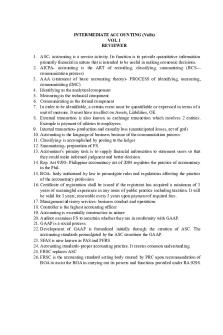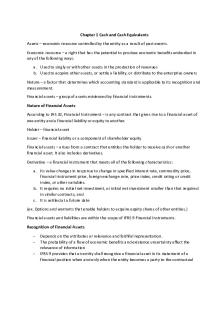4 Inventory Estimation Intermediate Accounting Reviewer PDF

| Title | 4 Inventory Estimation Intermediate Accounting Reviewer |
|---|---|
| Course | Financial Accounting 1 |
| Institution | Ateneo de Manila University |
| Pages | 3 |
| File Size | 204.9 KB |
| File Type | |
| Total Downloads | 64 |
| Total Views | 160 |
Summary
Inventory EstimationNeed to use of estimate in inventory valuation When taking a physical count is not possible Although physical count is possible, it is costly, difficult or inconvenient at the moment.Reasons for approximation (estimation) of inventory Required for insurance purposes, when in...
Description
Inventory Estimation Need to use of estimate in inventory valuation When taking a physical count is not possible
Although physical count is possible, it is costly, difficult or inconvenient at the moment.
Reasons for approximation (estimation) of inventory Required for insurance purposes, when inventory is destroyed by fire, calamities or theft Gross profit test : need to prove the correctness or reasonableness of the physical count of goods made Interim FS are prepared; physical count may take time 2 METHODS OF APPROXIMATING THE VALUE OF INVENTORY Gross Profit Method Retail inventory method Gross Profit Method Often used to estimated the value of an inventory from accounting records without taking physical count Based on the assumption that the rate of return of GP remains approximately the same from period to period Thus the ratio of cost of sales to net sales is relatively constant from period to period
Basic formula Goods available for sale Beginning inventory Purchases +Freight in
xx xx xx
-Purchase returns, allowances, discount Cost of GAFS Less : Cost of Sales (xx) Ending inventory
(xx)
xx xx xx
Cost of sales is computed by using any of the f Net sales x cost ratio used when the GP rate is based on sales Net sales / sales ratio used when the GP rate is based on cost Net sales – gross profit Gross Profit rate GP rate on Sales is 25%
GP rate on cost is 25%
Sales allowance and sales discount Ignored ; not deducted from sales While these items decrease the amount of sales, they DO NOT affect the physical volume of goods They do not increase the physical inventory of goods, UNLIKE in sales return where there is an addition to goods on hand. Result if these are deducted from sales : inventory is overstated; COGS is understated; gross profit is overstated.
Retail inventory method
Generally used by department stores and supermarkets where there is a wide variety of goods; Keeping track of unit cost at all times is tedious The selling price or retail price is tagged to each item ; retail means selling price
Basic formula Goods available for sale at retail or selling price Less: Net sales (Gross sales less sales return ONLY) Ending inventory at selling price Multiply: Cost ratio = Goods available for sale at cost/ Goods available for sale at selling price Ending Inventory at cost
xx (xx) xx x%
xx
Items related to Retail method INITIAL MARKUP ORIGINAL RETAIL
ADDITIONAL MARKUP MARKUP CANCELLATION
NET MARKUP MARKDOWN
MARKDOWN CANCELLATION
NET MARKDOWN
MAINTAINED MARKUP or MARKON
Original markup on the cost of goods The sales price at which the goods are first offered for sale Increase in sales price ABOVE the original sales price Decrease in sales price that does not decrease the sales price below the original sales price Markup – Markup cancellation Decrease in sales price BELOW the original price Increase in sales price that does not increase the sales price above the original price Markdown – Markdown cancellation Difference between cost and sales price (sales – cost) after adjustments for all of the mentioned items.
***** markdown and markup always depend on the original retail*****
Inventory, Beg, Purchases
Cos t xx xx
Ret ail
xx xx
Freight-in Purchase Return Purchase Allowance Purchase Discounts Additional Markup Markup cancellation Departmental transfer in debit Departmental transfer out credit Shortage, spoilage, shrinkage, breakable (abnormal) Goods Available for Sale Conservative/Conventional/l ower cost and net realizable value – cost/retail Markdown Markdown cancellation Net Purchases *Inventory, Beg. Is not included – FIFO – cost/retail Goods Available for Sale – Average – cost/retail Less: Sales Sales Return and Allowances Employee Discount Shortage, Spoilage, Shrinkage, breakage(Normal) Ending Inventory at retail Ending Inventory at cost C,C, LCNRV (cost ratio*ending inventory at retail) Ending Inventory at cost average (cost ratio*ending inventory at retail) Ending Inventory at cost FIFO (cost ratio*ending inventory at retail)
xx (xx) (xx) (xx)
Xx (xx)
xx
xx (xx) xx
(xx)
(xx)
(xx)
(xx)
xx
xx
xx
(xx) xx xx
xx
xx (xx) xx (xx) (xx) xx
xx
xx
xx
Approaches in the use of retail method Conservative or Excludes conventional or markdown and lower cost of markdown net realizable cancellation value Average cost of Includes approach markdown and markdown cancellation FIFO Approach Includes markdown and markdown cancellation; excludes the beginning
inventory
*note: The exclusion of beginning inventory is for cost ratio computation ONLY; it will still form part of the Cost of Goods Available for Sale computation The average cost approach shall be applied in conjunction with the retail inventory method If the problem is silent as to approach to use; then use average cost approach
Employee discounts Special discounts that are not recorded in the sales discounts account because they are directly deducted from the sales price Only the net sales price is recorded. Consequently, the amount of sales is understated. ADDED BACK to sales because these discounts decrease sales but they do not affect physical inventory Normal SSSB - shortage, shrinkage, spoilage, breakage Deducted from goods available for sale at RETAIL Absorbed or included in cost of goods sold Abnormal SSSB - shortage, shrinkage, spoilage, breakage Deducted from Goods available for sale at BOTH COST AND RETAIL before the calculation of cost ratio. This is in order not to distort the cost ratio Reported separately as LOSS, separate from cost of goods sold. Usually arise from theft or casualty *** if SSSB is silent, then it is considered as normal SSSB...
Similar Free PDFs

Reviewer for Intermediate Accounting
- 106 Pages

Intermediate Accounting Reviewer
- 5 Pages

Intermediate- Accounting
- 6 Pages

Intermediate accounting
- 3 Pages

Intermediate accounting
- 84 Pages

Intermediate Accounting
- 7 Pages
Popular Institutions
- Tinajero National High School - Annex
- Politeknik Caltex Riau
- Yokohama City University
- SGT University
- University of Al-Qadisiyah
- Divine Word College of Vigan
- Techniek College Rotterdam
- Universidade de Santiago
- Universiti Teknologi MARA Cawangan Johor Kampus Pasir Gudang
- Poltekkes Kemenkes Yogyakarta
- Baguio City National High School
- Colegio san marcos
- preparatoria uno
- Centro de Bachillerato Tecnológico Industrial y de Servicios No. 107
- Dalian Maritime University
- Quang Trung Secondary School
- Colegio Tecnológico en Informática
- Corporación Regional de Educación Superior
- Grupo CEDVA
- Dar Al Uloom University
- Centro de Estudios Preuniversitarios de la Universidad Nacional de Ingeniería
- 上智大学
- Aakash International School, Nuna Majara
- San Felipe Neri Catholic School
- Kang Chiao International School - New Taipei City
- Misamis Occidental National High School
- Institución Educativa Escuela Normal Juan Ladrilleros
- Kolehiyo ng Pantukan
- Batanes State College
- Instituto Continental
- Sekolah Menengah Kejuruan Kesehatan Kaltara (Tarakan)
- Colegio de La Inmaculada Concepcion - Cebu









